That said, we have come up with some of the best motherboards for i7 9700K CPUs that will be perfect for your gaming PC build. For a 9th gen Intel processor, a Z390 motherboard is the absolute best option to pick. But, you have to keep in mind a few other things while buying a new motherboard, such as:
Form-factor: First of all, you should decide the size of the PC you want to build and then choose a motherboard accordingly. In case you want to build a small-sized PC, go with ITX or mini-ITX motherboards. Otherwise, you can stick to the standard size, ATX motherboards. Chipset: While picking a new motherboard, always ensure that it supports your choice of CPU. As in this case, the Z390 motherboards will be the best option to choose from as they come with LGA1151 sockets that support both 9th and 8th Gen Intel processors. Memory Speed: Choosing a motherboard with 2 DIMM or 4 DIMM slots is your personal choice. However, don’t forget to check the max memory speed supported by the motherboard. A few motherboards out there can only manage up to 1000-2000MHz memory speed. While there are some other good options also that deliver up to 4500MHz speeds.
So, these were a few basic things that you should always keep in mind before picking a motherboard. However, that’s not all of it, there are actually a lot more factors that you should consider. If you want to know about all the factors, consider reading the detailed “Buying Guide” mentioned below as we have covered every considerable factor in it quite thoroughly. Until then, let’s take a look at the list of best motherboards for i7 9700K.
6 Best Motherboard for i7 9700K in 2023
Best Motherboard for i7 9700K in 2023: Reviews
1. GIGABYTE Z390 Motherboard
ASUS vs ACER Ryzen 7 3700x Vs Intel i7 9700k Best x470 Motherboards Best RGB Motherboards Best micro atx cases Best z690 DDR5 Motherboard
Gigabyte is a highly renowned brand in the gaming industry, and when it comes to hardware, it does offer high-quality motherboards apart from graphics cards. The Gigabyte Z390 Aorus Ultra motherboard deserves the 2nd position on this list because of its advanced thermal designs and highly durable build quality. You will notice heatsinks are provided on almost every section of this motherboard to keep the thermals in control. Coming over to the RAM section, it has 4 DIMM slots that offer dual-channel non-ECC unbuffered DDR4 memory support, for up to 4400MHz memory speed. On the left side, it has a highly durable LGA1151 CPU socket that supports all the 9th and 8th Intel Core processors, including the i7 9700K also. A huge reason for its commendable performance is the 12+1 Phases Digital VRM Solution with DrMOS offered on this motherboard. It’s great to see that all three of the M.2 slots come with thermal guards as well. Moreover, looking at the PCIe x16, x8, and x4 slots, all of them do have shielded connectors also. Since all the parts on this motherboard are well-protected, Gigabyte didn’t miss to equip this motherboard with an integrated I/O shield. Apart from that, there are plenty of unique features on this motherboard, such as RGB Fusion lighting, Intel CNVi 2×2 802.11ac Wi-Fi, and plenty of Fan and RGB headers for customization. Key Features:
ATX Motherboard Advanced Thermal Design 4 DDR4 DIMM slots Memory Speed up to 4400MHz 12+1 Phases Digital VRM Solution Intel CNVi 2×2 802.11ac Wi-Fi PCIe x16, x8, and x4 slots with shielded connectors Integrated I/O shield Supports 9th and 8th Gen, Intel Core / Pentium Gold / Celeron Processors Triple M.2 Slots
Pros:
Highly durable Maintains thermals pretty well Comes with in-build RGB lighting Front USB 3.1 Gen 1 Type-C Header
Cons:
A little expensive
2. ASUS TUF Z390-Plus Motherboard
Next up, we have a motherboard from Asus, another highly popular brand that’s dedicatedly manufacturers all kinds of gaming equipment and hardware. Generally, Asus products are expensive, but the TUF Z390-Plus Gaming motherboard isn’t, that’s why we are putting this one in 3rd place in this list. The motherboard is designed with an LGA1151 CPU socket which is good enough for all the 9th and 8th Gen Intel chipsets. Speaking about the RAM section, you get 4 DDR4 DIMM slots on this motherboard that support up to 4266MHz (OC) memory speeds for up to 64GBs of RAM capacity. The quality of the slots is fairly good, especially the PCIe x16 slot, which comes with metal shielding as well. There’s another PCIe x16 slot available for secondary GPU, and a bunch of PCIe x1 slots for other expansions. On the other hand, there are 2 32Gb/s M.2 x4 PCIe & SATA slots, out of which the primary one has M.2 Heatsink as well. The M.2 PCIe slots are also Intel® Optane Memory Ready which is great. Since it’s an ATX-size motherboard, there are a bunch of RGB headers, Fan headers. Apart from that, a USB 3.1 Gen 1 (up to 5Gbps) front panel connector is also present on this motherboard. Just like its name, the overall motherboard is built quite tough, equipped with Military-grade components like TUF LANGuard, TUF Chokes, TUF Capacitors, and TUF MOSFETs, etc. Moreover, the Realtek® S1200A audio codec allows you to experience 8-channel HD Gaming Audio. Key Features:
ATX Motherboard 4 DDR4 DIMM slots LGA1151 CPU socket Supports all 9th and 8th Gen Intel chipsets Support up to 4266MHz (OC) Memory speeds Two PCIe x16 Slots Twin 32GB/s M.2 x4 PCIe & SATA slots Intel Optane Memory Ready Realtek® S1200A audio codec Supports 802.11ac Wi-Fi
Pros:
Comes with Asus Optimem II for better memory stability Military-Grade Tough build quality Supports Aura Sync RGB lighting A great pick for overclocking
Cons:
Heat Management could be better
3. MSI MPG PRO Z390 Motherboard
In case you are looking for a highly-specced premium motherboard for your i7 9700K PC build, the MSI MPG Z390 Gaming PRO Carbon motherboard is the best pick for you. No wonder the motherboard has pretty expensive pricing but does offer that level of performance also. Just by looking at the design of its heatsinks, and VRM section, you can notice how premium it is! Speaking of the features you get on this motherboard, it’s compatible with all 9th and 8th gen CPUs from Intel, thanks to the LGA1151 socket, which even provides you with overclocking capabilities. At the right side of the socket, there are 4 solid DIMM slots that support dual-channel memory up to 4400 (OC) MHz. In addition, the motherboard also has 2 Turbo M.2 PCIe slots which are Intel Optane Memory Ready and have M. 2 Shield Frozr heatsinks for heat management. Apart from that, 3 Turbo USB 3.1 Gen2 connectors are also present for the front panel as well. A bunch of connectivity ports are there on the I/O back panel as well, which is well-protected with an integrated shield. For expansion and Graphics cards, it has 3 PCIe 3.0 slots, out of which 2 of the slots come with Steel Armor protection to provide support to the Graphics cards. You will love this motherboard if you like RGB lighting since it supports Mystic Light sync feature that lets you control all the RGB lights connected with the addressable headers. Overall this is a great ATX-size motherboard that delivers high performance and is perfectly suitable for any gaming PC build. Key Features:
ATX motherboard 4 DDR4 DIMM slots LGA1151 CPU socket Supports all 9th and 8th Gen Intel chipsets Support up to 4400 MHz (OC) Memory speeds Audio Boost 4 with Nahimic 3 3 PCIe 3.0 Slots 2 Turbo M.2 Slots, 1 M.2 Frozr Mystic Light Sync 3 Turbo USB 3.1 Gen2 connectors Intel Optane Memory Ready Supports 802.11ac Wi-Fi
Pros:
Heavily equipped with features Heat management is quite good Aesthetic Design Decent Overclocking performance
Cons:
Expensive
4. ASUS ROG Strix Z390-I Motherboard
Coming up next on this list, this motherboard from Asus is for those people who wish to build a Mini-tower PC; this Mini-ITX ROG Strix Z390-I Gaming motherboard is just perfect. The motherboard is superiorly compatible with all the 9th gen and older-generation CPUs from Intel. In such a small form-factor, it includes two DIMM slots that support dual-channel DDR4 RAM up to 2400MHz. Moreover, there are dual PCIe M.2 slots for storage drives, and even boasts two USB 3.1 addressable headers for the front panel connectivity. Speaking of connectivity, you will also be surprised to know that this mini-ITX motherboard also has dual-band Wi-Fi and a pre-mounted I/O shield that protects all the connectivity ports at the back. Additionally, there are 4 SATA ports available as well in case you need to expand storage further. It comes with a PCIe x16 Graphics interface which is good enough as you can use almost any Graphics card on this motherboard. Apart from that, it has all sorts of addressable headers for RGB lighting, fans, and even supports Fan Xpert 4 delivers a dynamic system for cooling. Along with that, the ROG Strix Z390-I Gaming motherboard also comes equipped with 802.11ac Wi-Fi which is quite commendable. The overall design and build quality of the motherboard is very satisfying, but the pricing is a bit too high. Key Features:
Mini ITX motherboard Dual PCIe M.2 Slots LGA1151 CPU socket Supports all 9th and 8th Gen Intel chipsets Supports Dual-Channel DDR4 RAM up to 2400MHz 2 USB 3.1 headers Fan Xpert 4 Cooling System 11ac Wi-Fi PCIe x16 Graphics interface 4 SATA ports
Pros:
Fantastic overclocking performance No issues regarding heat management Pre-mounted I/O shield Comes with Overcurrent Protection
Cons:
Only supports up to 2400 MHz memory speeds
5. ASRock Z390 Motherboard
There’s yet another good motherboard option for mini-PC builds, which is from a highly popular brand known by the name ASRock. ASRock didn’t put much attention to the design as you can see there are not any fancy decorative heat sinks designed aesthetically to improve its looks. Instead, this looks like a pretty straightforward motherboard that focuses more on performance. Speaking of its CPU socket, this Z390 motherboard is equipped with an LGA1151 socket that supports all the 9th and 8th gen Intel Core CPUs. Since it’s an ITX motherboard, there’s only space to include dual DIMM slots. But, they do support dual-channel DDR4 RAM up to 4500MHz (OC) memory speed which is great, and good enough for a high-performance computer. A decent heatsink module is actually there to keep the PCIe M.2 slot always protected and helps to prevent throttling due to overheating issues. Although the I/O panel does not have any pre-mounted shielding, it has all the necessary connectivity ports available. Moreover, the motherboard also has Wireless connectivity such as 802.11ac Wi-Fi and Bluetooth 5.0. For your powerful graphics card, there’s a dedicated PCIe x16 slot at the bottom which also has steel armor protection to prevent bending. Key Features:
ITX Motherboard LGA1151 CPU socket Supports all 9th and 8th Gen Intel chipsets PCIe x16 Graphics Interface Supports dual-channel DDR4 memory up to 4500 (OC) MHz. Wireless 802.11ac Bluetooth 5.0 PCIe M.2 Slot 4 SATA ports Nichron Audio
Pros:
Ideal option for mini-PC builds Greatly handles overclocking Decent Build-quality Has a thunderbolt connector also
Cons:
Heats up slightly
6. MSI MPG Z490 Gaming Plus Gaming Motherboard
Last on this list, we have an amazing motherboard from MSI, a popular brand making motherboards dedicated to gaming. This MSI MPG Z490 gaming plus carbon motherboard is the best budget-friendly option with various features for gamers. This Gaming Plus Gaming Motherboard features an ATX motherboard that delivers high performance and is perfectly suitable for any gaming PC build. Since it is equipped with a Z490 chip, it comes with an LGA 1200 socket that supports all the 10th Generation Intel CPUs, including the Pentium Gold/Celeron processors. Alternatively, you get 4 DIMM slots on the motherboard supporting dual-channel DDR4 memory up to 4800 (overclockable OC) MHz or 128GB. In addition, the motherboard has 2 Turbo M.2 PCle 3.0 X 16 slots which are Intel Optane Memory Ready, and has M.2 Shield Frozr Heatsinks for effective heat management that deliver transfer speeds of up to 32 GB/S to have ultra-fast SSDs. Apart from that, Turbo USB 3.2 Gen2X2 Type C port and 2.5G LAN are available for the front panel for low-latency network connectivity. A lot of connectivity ports are there on the I/O back panel, which is protected with an integrated shield. Coming to the expansion and graphics cards, it is fortified with PCI-Express steel armor slots to protect the motherboard with extra solder points and support the graphics cards (heavier ones). As this safeguards the contact point from electromagnetic interference. However, its pre-installed IO shielding handles the motherboard safer and easier. You will love this motherboard if you like RGB lighting since it supports the Mystic light sync feature (with 16.8 million colors) that allows you to control all the RGB lights connected with the addressable headers. Key Features:
ATX motherboard 4 DDR4 DIMM slots LGA1200 CPU socket Supports all 10th Gen Intel chipsets Supports up to 4800 MHz (OC) memory speeds 3 PCle 3.0 slots Audio boost with HD audio processor, high-quality audio capacitors, and audio jacks with S/PDIF 2 Turbo M.2 Slots, 1 M.2 Frozr Turbo USB 3.1 Gen2 connectors Mystic Light Sync Intel Optane Memory Ready 6 SATA ports Supports 802.11ax Wi-Fi/wireless type
Pros:
Decent overclocking performance A budget-friendly option with an aesthetic design Good heat management Comes with plenty of SATA ports Heavily equipped with features
Cons:
Nothing found
Buying Guide for the Best Motherboard for i7 9700K
Whenever you are thinking of building a new PC, choosing the right combination of hardware is always a crucial task. You have to keep in mind how much RAM would be enough for your work. Similarly, you have to choose the other components like Storage drives, Graphics cards, etc., accordingly. Well, as you have already picked up the Intel i7 9700K CPU for your PC build, you should be choosing a motherboard that supports the CPU as well as the other hardware. As you can see in the above list, there are so many good options available out there. But, in case you are not able to pick the right one for yourself, you should read this buying guide until the end thoroughly. It will help you know better about motherboards so that you can pick one for your PC build wisely.
Form-factor
Not all PC builds are of the same size, you must have seen people build quite huge towers as well as console-sized small ones also. Depending on what you like to build, you are supposed to pick the right size motherboard for your build. Generally, most people go with ATX motherboards as it’s quite a standard size and is ideal for mid-tower builds. Using an ATX motherboard in large computer builds won’t be an issue as it will fit there easily. However, if you wish to build a smaller PC, an ITX or mini-ITX motherboard would be good for you. Moreover, the benefit of choosing a larger motherboard is that you will find more expansion options there. In contrast, small-sized motherboards have limited space, so you will have comparatively fewer slots on such motherboards.
CPU Socket
While choosing a motherboard, the main goal is to pick the motherboard which could support all the hardware that we are going to put in there, especially the processor. As for this scenario, we have already decided to use i7 9700K CPU, so you should check whether the motherboard has the right CPU socket for this particular chipset or not. Since the i7 9700K is a 9th Gen Intel processor, the Z390 Motherboards are the best one for this chipset. It is because the Z390 motherboards come with the LGA1151 sockets which support all the 9th Gen as well as 8th Gen processors from Intel. In the Z-series motherboards, you will come across Z370 Motherboards as well. But avoid picking them as the Z390 is a better choice over it, and offers much better all-round system stability and overclocking capabilities.
Memory Slots
As you might already know, RAM is one of the most essential parts of any PC. It’s always suggested to not compromise while choosing the RAM for your PC since it plays a significant role in providing performance to the computer. That said, the more RAM you have on your PC, the better it will perform. But, not all motherboards are the same as some only come with two memory slots, whereas some motherboards have four slots as well. No doubt, the motherboard with more slots is surely going to cost more. In case you want to load up your PC with a bunch of RAM sticks to achieve like 32GB or 64GB RAM, the motherboard with 4 slots should be your pick. Otherwise, you can choose the 2 RAM slot motherboard and put in two 8GB RAM sticks in it. To be honest, 16 gigs of RAM is just fine, until and unless you are doing some seriously heavy work on your PC. Moreover, pay attention to the generation of RAM the motherboard supports. The latest generation of RAM currently is DDR4. So, you shouldn’t pick a motherboard that doesn’t support DDR4 memory.
PCI Slots
PCI slots are basically the expansion slots that you will find on all motherboards. Generally, the PCI slots are used to add video cards, sound cards, LAN cards, and much more to the PC. If we specifically talk about the Graphics cards, they use a 16X PCI slot on the motherboard as it gives the best performance output. On the other hand, you will notice other PCI slots with different configurations as well such as 8X, 4X, and 1X also. The slots almost look identical, so you should be careful while building the PC and use the right slot. It’s possible to put a 16X card in an 8X slot, however, it won’t be practically right since the slot will limit the power to 8X as it can’t push itself any further. Therefore, if you are building a gaming PC, make sure the motherboard does have PCI x16 slots since they are the best to put a graphics card into.
SATA Ports
Normally, you won’t find any issues regarding the SATA slots on any motherboard since manufacturers usually provide plenty of slots. However, to use your HDD and SSD drives, you should definitely check if the slots are of the latest generation or not. In the case of SATA ports, it’s important to check that the ports should be SATA 6 Gigabyte ports as they provide good data transfer speeds. In other words, most manufacturers also mention them as SATA 3.0 ports, which is basically the same thing. The additional thing you can check along with is that the SATA3.0 ports should be connected to the USB 3.0 interface so that you can experience the top-notch read/write speeds.
Wi-Fi
Next up, you can check for some additional features on the motherboards such as the Wi-Fi. Generally, if you are building a gaming PC, WiFi is totally an optional thing to consider since most gamers prefer playing on wired LAN connections only. However, if you don’t have a direct internet connection, or the router is not in the computer’s reach, you have to consider a motherboard that comes with Wi-Fi. To make sure the motherboard has the latest Wi-Fi card installed, you can check the supported Wireless standards. Although Wi-Fi with 802.11/n standard can handle up to 100Mbps speeds easily. It’s better to opt for the motherboard which has 802.11ac or Wi-Fi 5 support as it provides better speed than n-standard Wi-Fi.
Other Features
Apart from all the important aspects, you can consider checking the audio cards that come pre-installed in most motherboards. Keeping that aside, if you are into RGB lighting, the available RGB headers will help you put life in your PC rig. Moreover, motherboards usually have plenty of fan headers as well that will help you connect fans in your PC rig for maintaining the thermals.
Conclusion
That’s it! These were our top picks of the best motherboards for i7 9700K that you can consider using in your PC build. Since we have covered motherboards of almost all price ranges and form-factors in this article, it should not be a hard task for you to pick the best suitable one for your PC. If you are purchasing a motherboard for the first time, we recommend you read the buying guide first and then proceed to check out the options as it will be a lot more beneficial for you to make a better choice. However, if you are still not able to pick a motherboard from the list or have confusion going on in mind. We have a few of our personal recommendations for you that you will not regret buying.
First of all, the MSI MPG PRO Z390 Motherboard is our personal favourite since it does provide you with all the features and comes for very attractive pricing. It offers you 4 DIMM slots, supporting memory speed up to 4400 MHz. Moreover, it stays quite stable even after overclocking, so you will definitely like using it. On the other hand, the GIGABYTE Z390 motherboard is a great purchase if you want a stylish motherboard with adjustable RGB features. Apart from that, you get all the necessary features as dual-channel RAM support, heatsinks for thermal management, and even the Intel CNVi 2×2 802.11ac Wi-Fi, all in one package. If build quality is your first concern, there’s nothing tougher than the ASUS TUF Z390-Plus Gaming Wi-Fi motherboard. It has great overclocking capabilities and comes with dual M.2 x4 PCIe slots for storage. Apart from that, it also has dual PCIe x16 slots for multi-GPU configuration.
Comment * Name * Email * Website
Δ



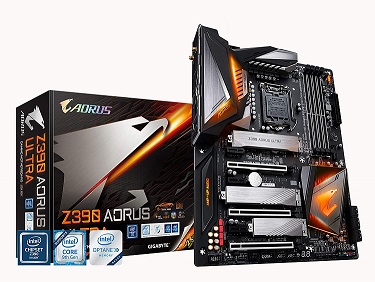
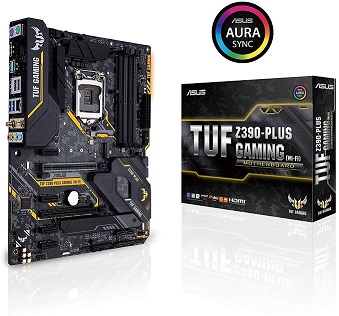
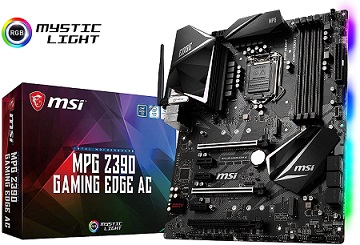
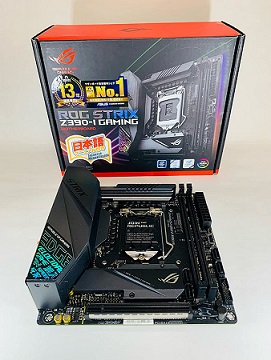

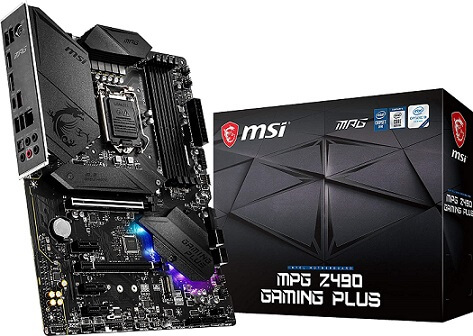


![]()